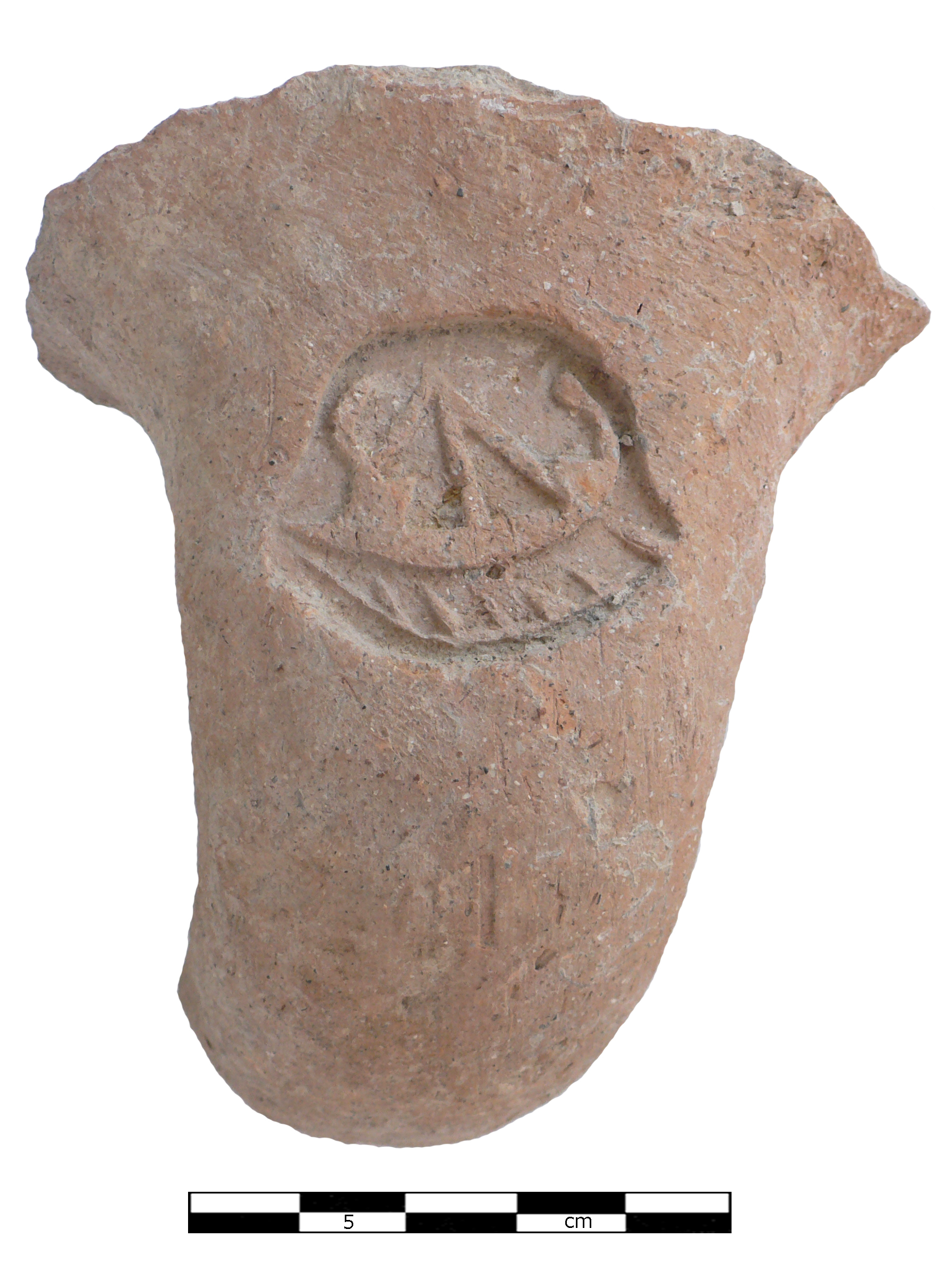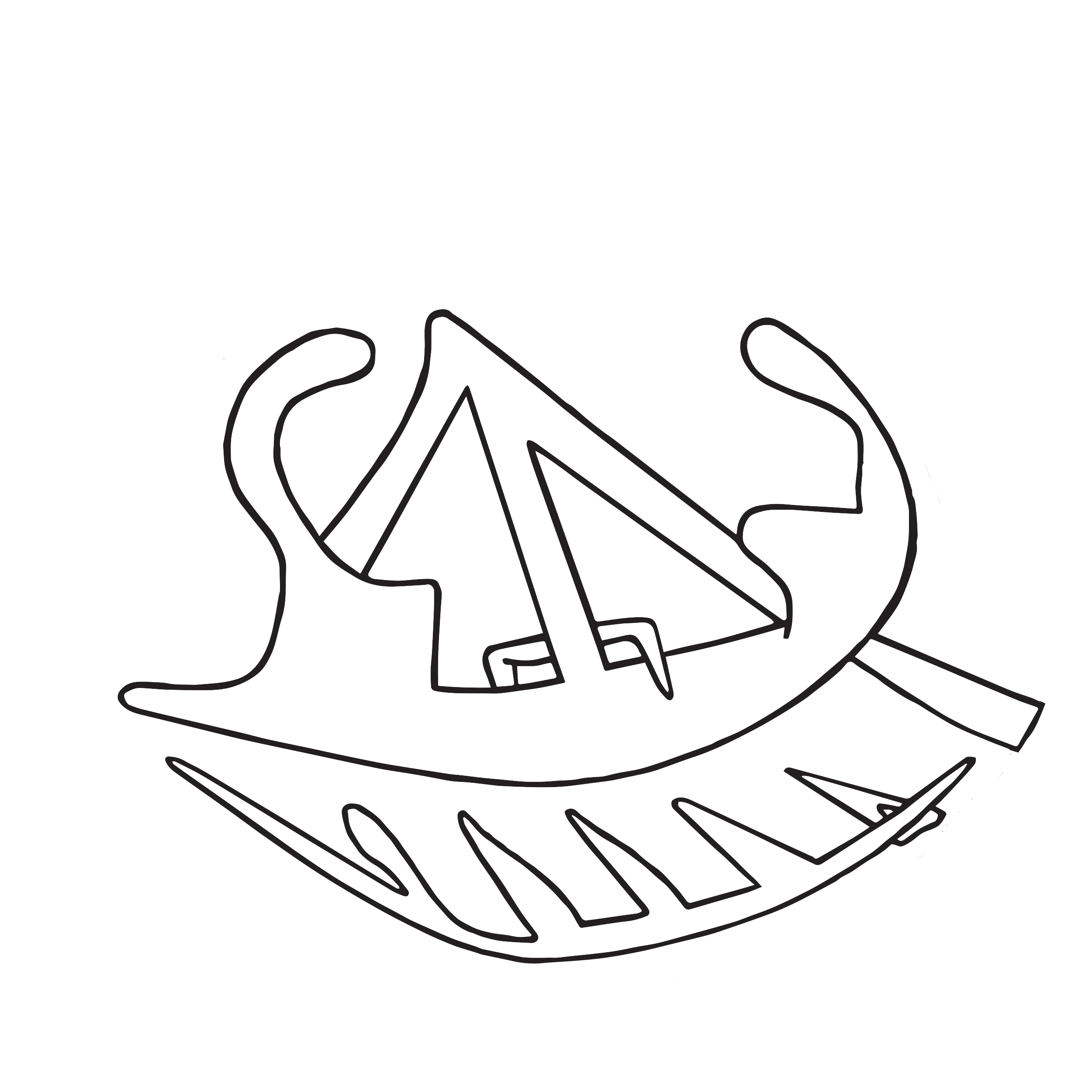Ship to the left with a low, slightly rockered keel line and high posts. Massive square bow with a vertical stempost ending in a long incurving horn device with a rounded tip. The bow projection extends straight from the keel line and is clearly integrated to the stempost. The solid, rectangle shaped forecastle is likewise integrated. The high incurving sternpost ends in a similar horn device, except that it is a little shorter, and ends in a slightly flaring extremity. The aftercastle is smaller, and has a curving, concave inner side in contrast to the straight edge of the forecastle. The mast is amidships, with a fore- and backstay. The mast step is indicated by two L-shaped lines on either side of the mast, forming a low rectangular tabernacle. Five oars appear below the keel line. These flare out towards their oar blades, giving them a roughly triangular appearance. A single quarter rudder aligned with the backstay extends below the hull. It is more rectangular in shape compared to the oars and was rendered with a deeper incision. A crescentic baseline frames the oars at the bottom of the composition.
Levantine galley
L20
11th century B.C. temninus ante quem
Tell Tweini, Syria
H of impression: 2.9 cm; W (top): 2.8 cm; W (bottom): 3.8 cm
Sealing on the handle of a Canaanite storage jar
Brandl and Yahalom-Mack 2022: 245-246, fig. 5c; Bretschneider and Van Lerberghe 2010: 33, 38, fig. 30; 31, 38, ill. 39; Emanuel 2016: 278; Knapp 2019: 125, fig. 27; Manolova and Bretschneider 2019
The LBA II occupation of Tell Tweini is characterized by large buildings with stone pavements and staircases. The architectural features and material culture in general mirror synchronous levels at Ugarit and point to the same cultural developments. The excavators have argued that the site was the southernmost harbour town of the kingdom of Ugarit - close to the border with the kingdom of Siyannu - and can be identified as Gibala, which is mentioned in a treaty between the Hittite king Mursili II and the king of Ugarit Niqmepa. That the site was a node within the elaborate network of international relations and maritime commercial activities during this period is indicated by the many imported luxury goods and pottery. These comprise a wide range of Cypriot (Base-Ring Ware II, White Slip II, Red Lustrous Wheelmade Ware and Red on Black Ware) and Late Helladic (LH IIIA:2; LH IIIB) ceramics, as well as several notable finds including seal cylinders, a bronze ring with illegible signs, and a bifacial seal with an inscription in hieroglyphic-luwian bearing the personal name 'Sakapiya.' The site was partially destroyed by a conflagration more or less contemporaneously with the destruction of Ugarit (c.1194-1175). The occurrence of bronze arrowheads suggests fighting within the city.
Tell Tweini was rebuilt immediately and remained occupied throughout the 12th and 11th centuries, with large-scale urbanization discernible by two main architectural phases during Iron I. Ceramics wise, the beginning of the EIA shows continuity of the local material culture but without the imports from Cyprus and the Aegean. Sporadic locally made LH IIIC early ceramics occur already in the destruction layer, which means that their production must have begun prior to the conflagration (Jung 2010). The 11th century is defined by amplified building activity as well as the reappearance of luxury items and imported pottery, notably Cypriot White Painted I (Nys and Middernacht 2010: 125-126), which indicates that Tell Tweini quickly resumed its maritime commercial operations.
The jar handle with the ship sealing was found at the center of the tell (Field A), in a locus consisting primarily of a thick deposit of debris within a large LBA building which was reoccupied during the EIA subsequent to its destruction. This layer contained large amounts of fragmentary ceramics dating to the LBA- EIA periods, including LH IIIB imports and locally produced Aegean style (LH IIIC) vases. The latest ceramic find from the locus is an 11th century Cypriot skyphos (Jung 2010). This find provides a terminus ante quem for the sealing, since other criteria typically used for dating purposes such as the seal shape, style and subject are of no help in this particular case. For a detailed discussion of the seal, see Manolova and Bretschneider 2019.
This representation is extremely important on several grounds (Manolova and Bretschneider 2019). Syro-Canaanite ship depictions are very rare, especially ones that are not produced by outsider sources. The only other local depictions from the Syrian coast are the Hama urn (thought to belong to an intrusive culture) and the Ugarit seal. Both of these are slightly earlier, dated to the very end of the LBA. What makes it unique however is that it represents a galley rather than a merchant vessel. Its design is remarkably similar to Aegean galley representations of MG II and transitional MGII-LG I date (c. 800-760). The similarities extend to all the essential elements, such as the shape of the bow and stern, the transition of the bow projection to the stempost, and the stem and stern terminals. The most noteworthy aspect of this vessel from an evolutionary point of view is its bow morphology, which belongs to Group 6 according to Wedde's classification (Wedde 2006: 258-59). As such, it puts the entire chronology and origin of the galley into question, which to this point had been attributed to the Mycenaean nautical tradition.
Brandl, B. and Yahalom-Mack, N. 2022. “A Clay Pendant with an Impression of a Phoenician Seagoing Ship from Tel Abel Beth Maacah,” in Davidovich, U. Yahalom-Mack, N. and Matskevich, S. (eds.). Material, Method, and Meaning: Papers in Eastern Mediterranean Archaeology in Honor of Ilan Sharon. Tubingen, pp. 241–252.
Bretschneider, J. and K. Van Lerberghe. 2010. “Tell Tweini à travers les millénaires: l’histoire et l’archéologie,” in M. Al-Maqdissi, K. Van Lerberghe, J. Bretschneider and M. Badawi (eds.) Tell Tweini: onze campagnes de fouilles syro-belges (1999-2010). Documents d’archéologie syrienne. Damascus: Ministere de la Culture, Direction Générale des Antiquités et des Musées, pp. 15-76.
Emanuel, J.P. 2016. “Maritime Worlds Collide: Agents of Transference and the Metastasis of Seaborne Threats at the End of the Bronze Age,” Palestine Exploration Quarterly 148.4: 265-280.
Knapp, A. B. 2018. Seafaring and Seafarers in the Bronze Age Eastern Mediterranean. Leiden: Sidestone Press.
Manolova, T. and J. Bretschneider. 2019. “An Unprecedented Depiction of a Syro-Canaanite Oared Galley on a Jar Sealing from Tell Tweini,” in J. Bretschneider J. and G. Jans (eds.), About Tell Tweini (Syria). Artefacts, Ecofacts and Landscape. Research Results of the Belgian Mission. Orientalia Lovaniensia Analecta 281. Peeters, pp. 117-148.



